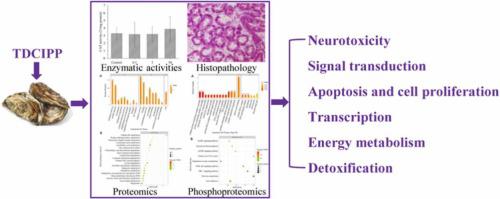Journal of Hazardous Materials ( IF 12.2 ) Pub Date : 2022-03-31 , DOI: 10.1016/j.jhazmat.2022.128824 Chengcheng Yin 1 , Zuodeng Sun 2 , Chenglong Ji 3 , Fei Li 4 , Huifeng Wu 3

|
As a typical organophosphorus pollutant, tris(1,3-dichloro-2-propyl) phosphate (TDCIPP) has been widely detected in aquatic environment. Previous studies showed that protein phosphorylation might be a vital way of TDCIPP to exert multiple toxic effects. However, there is a lack of high-throughput investigations on how TDCIPP affected protein phosphorylation. In this study, the toxicological effects of TDCIPP were explored by proteomic and phosphoproteomic analyses together with traditional means in oysters Crassostrea gigas treated with 0.5, 5 and 50 μg/L TDCIPP for 28 days. Integration of omic analyses revealed that TDCIPP dysregulated transcription, energy metabolism, and apoptosis and cell proliferation by either directly phosphorylating pivotal proteins or phosphorylating their upstream signaling pathways. The U-shaped response of acetylcholinesterase activities suggested the neurotoxicity of TDCIPP in a hormesis manner. What’s more, the increase in caspase-9 activity as well as the expression or phosphorylation alterations in eukaryotic translation initiation factor 4E, cell division control protein 42 and transforming growth factor-β1-induced protein indicated the disruption of homeostasis between apoptosis and cell proliferation, which was consistent with the observation of shedding of digestive cells. Overall, combination of proteomic and phosphoproteomic analyses showed the capability of identifying molecular events, which provided new insights into the toxicological mechanisms of TDCIPP.
中文翻译:

使用蛋白质组学和磷酸蛋白质组学分析对牡蛎牡蛎中三(1,3-二氯-2-丙基)磷酸酯的毒理学影响
作为一种典型的有机磷污染物,磷酸三(1,3-二氯-2-丙基)酯(TDCIPP)已在水环境中被广泛检测到。先前的研究表明,蛋白质磷酸化可能是 TDCIPP 发挥多种毒性作用的重要途径。然而,缺乏关于 TDCIPP 如何影响蛋白质磷酸化的高通量研究。在这项研究中,通过蛋白质组学和磷酸蛋白质组学分析以及传统方法在牡蛎中探索了 TDCIPP 的毒理学作用。用 0.5、5 和 50 μg/L TDCIPP 处理 28 天。组学分析的整合揭示了 TDCIPP 通过直接磷酸化关键蛋白或磷酸化其上游信号通路来失调转录、能量代谢和细胞凋亡和细胞增殖。乙酰胆碱酯酶活性的 U 形反应表明 TDCIPP 的神经毒性以一种兴奋的方式。更重要的是,caspase-9活性的增加以及真核翻译起始因子4E、细胞分裂控制蛋白42和转化生长因子-β1诱导蛋白的表达或磷酸化改变表明细胞凋亡和细胞增殖之间的稳态被破坏,这与消化细胞脱落的观察结果一致。总体,






































 京公网安备 11010802027423号
京公网安备 11010802027423号